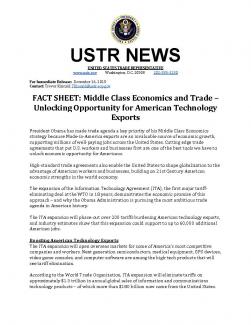President Obama has made trade agenda a key priority of his Middle Class Economics strategy because Made-in-America exports are an invaluable source of economic growth, supporting millions of well-paying jobs across the United States. Cutting edge trade agreements that put U.S. workers and businesses first are one of the best tools we have to unlock economic opportunity for Americans.
High-standard trade agreements also enable the United States to shape globalization to the advantage of American workers and businesses, building on 21st Century American economic strengths in the world economy.
The expansion of the Information Technology Agreement (ITA), the first major tariff-eliminating deal at the WTO in 18 years, demonstrates the economic promise of this approach – and why the Obama Administration is pursuing the most ambitious trade agenda in American history.
The ITA expansion will phase-out over 200 tariffs burdening American technology exports, and industry estimates show that this expansion could support to up to 60,000 additional American jobs.
Boosting American Technology Exports
The ITA expansion will open overseas markets for some of America’s most competitive companies and workers. Next generation semiconductors, medical equipment, GPS devices, video game consoles, and computer software are among the high-tech products that will see tariff elimination.
According to the World Trade Organization, ITA expansion will eliminate tariffs on approximately $1.3 trillion in annual global sales of information and communications technology products – of which more than $180 billion now come from the United States.
Industry estimates indicate that a successful expansion of the ITA agreement woulld:
- Support up to 60,000 additional U.S. jobs.
- Increase annual global GDP by an estimated $190 billion.
- Foster productivity and growth across the global economy, especially in the developing world.
Eliminating Tariffs on a Wide Range of American Technology Products
ITA Expansion supports U.S. manufacturing and technology industries. Tariffs will be eliminated on many products key to U.S. industries that support good jobs, including in the manufacturing and technology sectors. A sample of some of the impacted products and the size of the tariff reduction they would benefit from, include:
- Next generation semiconductors – Tariffs up to 25 percent reduced to zero.
- Magnetic Resonance Imaging (MRI) machines – Tariffs up to 8 percent reduced to zero.
- Computed Tomography (CT) scanners – Tariffs up to 8 percent reduced to zero.
- Global Positioning System (GPS) devices - Tariffs up to 8 percent reduced to zero.
- Printed matter/cards to download software and games – Tariffs up to 10 percent reduced to zero.
- Printer ink cartridges – Tariffs up to 25 percent reduced to zero.
- Static converters and inductors – Tariffs up to 10 percent reduced to zero.
- Loudspeakers – Tariffs up to 30 percent reduced to zero.
- Software media, such as solid state drives - Tariffs up to 30 percent reduced to zero.
- Video game consoles – Tariffs up to 30 percent reduced to zero.
- An expanded ITA will also eliminate import duties on a range of additional technology products including high-tech medical devices, video cameras, and an array of high-tech ICT testing instruments.
Background
The original ITA was concluded in 1996, and it has been a boon for the U.S. economy. But despite the tremendous growth in global trade in technology products, which has nearly tripled to over $4 trillion annually, the scope of the ITA had never been updated. To grow these benefits and capitalize on American technological advantages, President Obama engaged the United States in negotiations to expand the ITA in 2012.

